
The ensuing commentary begins with a problem that one of my friends or I were trying to solve by making an old vacuum cleaner into a flamethrower or attaching a rocket engine to a bicycle or dismembering an antique radio in the mistaken belief that, resorted, its parts could become a really cool tape recorder.
We all grew up, to the extent that we do not now destroy working things in an effort to make them into something that they obviously cannot become. But I’m not sure the desire to tinker with things for their if not our improvement ever completely dies.
No, it is an animating thread that runs through our lives, always there and eager to solve any real or imagined problem. If we’re going to fix something, why not make it into what we really wanted all along? And if we can’t fix it, why not make something else into what we really wanted all along?
It’s not as if I awaken each morning looking for something to break. But when something does break I’m perfectly willing to stride boldly into vaguely charted areas in coming up with a replacement. As a result, my reaction last week was irritation, not despair, when my trusty iPad decided to go all happy pixels on me.
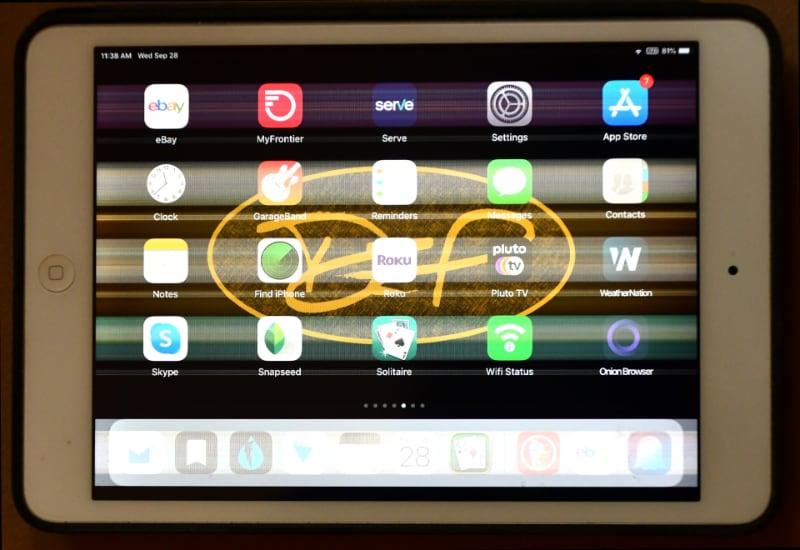
The iPad Mini 2, which I got new eight years ago next month, has been more than useful. It’s where I read the mail and the news each morning as I enjoyed my morning coffee (or, lately, matcha). When I watched television, it was nearby for me to use when I wanted to know more about some figure or event or when I wanted to learn the real details of a dramatized incident (or when I simply wanted to figure out where I’d seen that actor before). It was not my first tablet computer — I fell for the H-P TouchPad during the six weeks between its release and its withdrawal (yes, you read correctly); later, I had and loved the BlackBerry PlayBook (and yes, the space bar seems broken at the offices where H-P and BlackBerry name things). I’d still be using the PlayBook(s — I have two of them) if BlackBerry hadn’t embraced corporate suicide. (I do wish BlackBerry would at least release the tech specs and unlocking details of those devices, because there are a lot of us who would like to make them useful once again.)
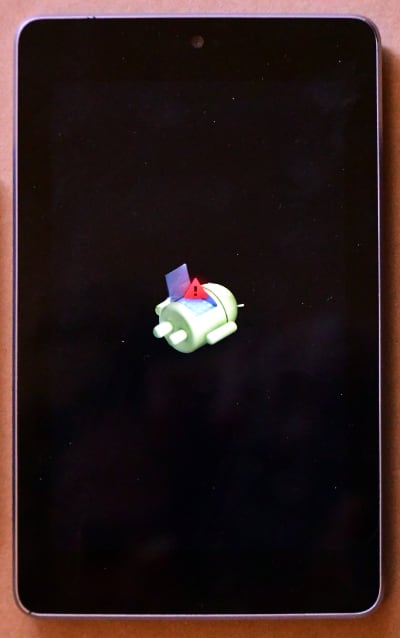
I had (and still have, and it sort of worked until I broke it Monday, about which more in a bit) an Asus Nexus tablet that ran some flavor of Android, Google’s spyware corruption of the Linux operating system. It worked, but using it made me feel dirty. There were few alternatives. No, there was no real alternative at the time, eight years ago. Work was underway on a de-Googled Android, which I guess ultimately sort of worked, and a wild-eyed plan to get it run some of real, honest Linux. I tried the latter on it, without much hope — I’d “run” a kind of Linux on the TouchPad and the result was lamentable — and my lack of hope was vindicated when I ended up with a Nexus pad that would boot Linux and even its applications (even LibreOffice, can you imagine it?) but they hadn’t gotten the mouse pointing worked out so it was more a video game than a way to do anything useful. But it wasn’t a spyware device anymore, which feature could have been imparted by driving the car over it. (On Monday I tried to “upgrade” its operating system, but the result was only a lovely picture of a Google Android robot lying on its back, apparently dead.)
So the lone choice was an iPad, which I got and which is now broken. The video has gone all streaky and while it’s still technically readable there’s no pleasure in it.
So I looked around at what’s on hand. The TouchPad died a long time ago and is one of the few electronic devices I’ve actually thrown away, though I still have its very good bluetooth keyboard (which, if it had a pointing device, would have made the Nexus-Linux tablet nearly usable). I have my iPhone SE, purchased refurbished for $96, but it’s too small for extended reading. I have some gadgets, including the Planet Computers Gemini which sad to say I find kind of unpleasant to use even if I do have Linux on it (as well as Sailfish OS, about which more in a paragraph or two), and a GPD Pocket, which runs a full Linux distribution and is pretty cool, but if its little fan port gets blocked it will burn up, so it’s not good for plopping down next to you on the couch. (It’s a tremendous little sub-notebook computer, though, and I’ve plugged a big monitor, trackball, and keyboard into it and used it for big-boy computing.)
Hmmm. What else was around. Oh, yeah.
When my local phone-internet provider announced in 2018 that they were now selling my email to some outfit called OATH, who would read it all and resell anything useful it found there, I switched to the excellent ProtonMail. But there was no good way to get or send mail through that great service using my BlackBerry (phone, not PlayBook). I needed to switch phones. The best for the money at the time was the Sony Xperia X, a nice phone with a great screen and very good specifications. What’s more, unlike most of the Google-sycophant phone makers, Sony was perfectly happy for you to crack it open and install a different operating system. I could get one with all the bells and whistles, new in the box, for about $100. So that’s what I did. Then I installed Sailfish OS on it.
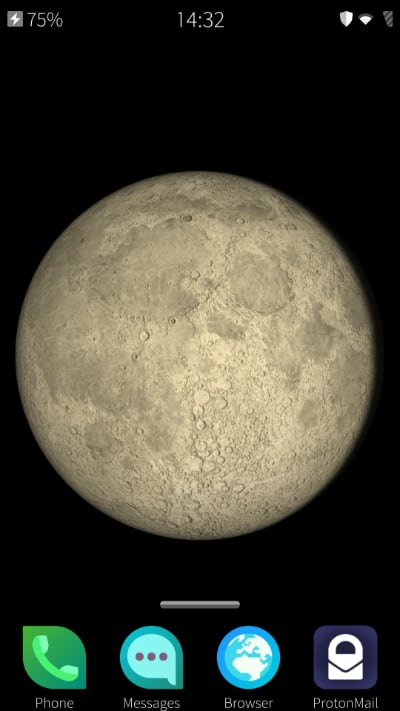
A person who isn’t willing to break something to make it into something else would not have undertaken it, but I’m not that person. I’d heard good things about Sailfish (actually, more about its potential — software is like that). Having gotten an Xperia X on which to install Sailfish OS, I set about doing it.
The first little bump in the road is that Jolla, the company that makes Sailfish, won’t sell it to anyone in the U.S. I do not know why. They’re in Finland, so they’re scarcely enemies — Linus Torvalds, the inventor of Linux, is from Finland and lives here now. The fact, reasonable or not, was the fact, so I had to use the VPN (in this case, the one built in to the Opera browser) to pretend to be in Europe before I could give them their $60 to download their operating system. Which I did.
Reflashing a phone is not for the faint of heart. It’s a fiddly process that you do not understand as you progress — you simply must follow the instructions, all of them, to the letter. Even then it does not always work. You need skill, luck, or both to succeed at burning a new operating system into a telephone. I am not skillful, but I am lucky. And in due course I was booting my shiny new Xperia X running the then-current version of Sailfish OS.
Then came the long process of making it my own. This included downloading many applications, trying them, and deleting most of them. It also included enabling its utility that allows it to run some Android applications, which I got from anti-Google sites. I even got it to run the Linux XPlanet application to make a real-time photographic moon-phase background. It was pretty cool. What’s more, you could update the whole system with a single click (well, slide) on the settings page. But then one update destroyed my days of careful configuration. I said to hell with it and got my little iPhone. The Xperia X went into the drawer of dashed dreams, alongside what’s effectively a museum of BlackBerry phones.
The small screen of the Xperia X, though, was big enough that one could, with reading glasses, use it as a sort of tiny tablet, so when the iPad started choking I thought I’d maybe give it a go. It had been long enough that I needed to give it another Sailfish upgrade, but now doing so put it into an endless reboot cycle. Ugh.
So, pretending to be in Europe again, I logged into my Jolla account and downloaded the free upgrade. Then I got to reflash the phone once more. It went more smoothly than I had reason to expect. But now many of the things I’d liked about it were no longer available. Many things that had worked before don’t anymore — for instance, the ProtonMail application and ProtonVPN, to say nothing of my beloved moonphase active wallpaper. Time to rethink.
Bear in mind, this was a perfectly fine, brand-new phone, albeit one running Google’s execrable Android, when I got it. So I met the requirement of ruining something that worked in an effort to turn it into something else.
Again I surveyed the alternatives. There’s a kind of clone Android —there may actually be two of them — which I looked at. It might solve many problems, but there’s more wrong with Android than just Google. What else was there?
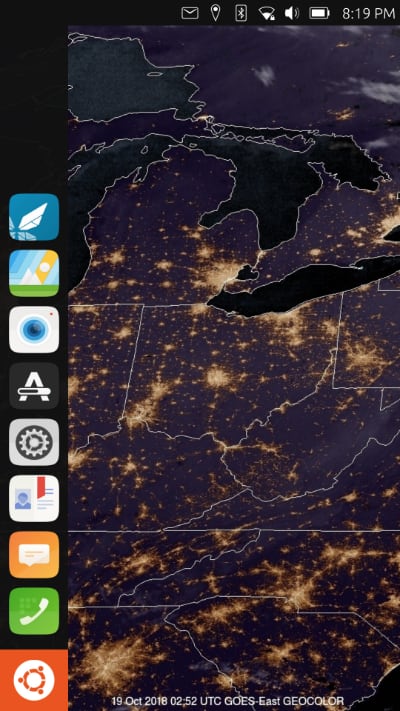
Time to take another look at Ubuntu Touch. It’s gone through some changes in the last eight years, not the least being its abandonment by Canonical, the company that makes Ubuntu, and its revival by a volunteer outfit called ubports, whose web page is unfortunately a collection of random clip art, too much animation, loads of happy talk and little else. You have to dig a bit to figure out what’s going on. That might already explain why it’s not exactly sweeping the world. What’s more, it has absolutely no useful user documentation — you’re on your own once you have it installed, which fortunately is well enough documented that a good amateur detective (who has luck if not skill) can figure it out. Well, to some extent, because the fact is that at this stage Ubuntu Touch sucks less than it did in its early days but, no surprise here, it still sucks.
For instance, its happy talk is all about your privacy and control, but if you want to use a VPN to preserve your privacy, you will have to cobble it together yourself because Ubuntu Touch can’t use the standard OVPN files produced by every VPN service I know of. In fact, best I can tell there’s pretty close to no attention paid to online security; I don’t think you can even specify your domain nameserver, which means Google knows everything you do online.
It offers many applications, but the majority of them are webapps, which is to say bookmarks with code wrapped around them. It does, though, have a very good web browser, though its features are limited.
Do you want to put the applications you wish to use on the application launcher bar, and remove the ones you don’t use? I wish you luck in finding out how to do it, because Ubuntu Touch is not, as they say, intuitive. (Would you guess — intuit — that to remove an application you need to open the app store and click on the little trashcan icon? If that’s documented someplace, I didn’t find it, and I looked.)
This is not an outrage. That a volunteer effort made it this far — and are still going — is astounding and would be unbelievable but for the previous example, Linux, which I’ve used exclusively as my desktop operating system for a few months shy of 25 years. But Ubuntu Touch ain’t soup yet, except for those willing to spend a lot of time tweaking. I’m a little troubled that while there seems to be a robust developer community, there’s not much of an online user presence that I can find. This is important, because users need a place to say “this isn’t working” or how do I do this?” without getting slapped down by developers who don’t like to be bothered by mere users. (This was a persistent problem for the first 15 years or so that Linux existed.)
I’ve looked at the Lineage clone of Android, which is an improvement but it takes a few days of work to de-Google even that, so pervasive is Google’s invasion of the internet. The MicroG project has made great strides in de-Googling Android by producing free alternatives to Google Play Services, the candy that Google offers the little girl to entice her into the car. It even has a pre-de-Googled Lineage, but it seemed that there was no pre-built version that can just get flashed to any device I own.
The state of the privacy art at this point is the “/e/OS” — terrible name — and I’d switch to it today if there were a version for anything I have, but there isn’t, and I’m past the point of buying a phone for the purpose of installing some promising operating system. So for my Sony phone, whose screen looked mighty small as I had my matcha this morning, it seemed to come down to Sailfish OS (which does not have a decent browser and which despite being farther along is at least as annoying as Ubuntu Touch) or Ubuntu Touch itself, with the knowledge that at this point it’s dangerous to use at all.
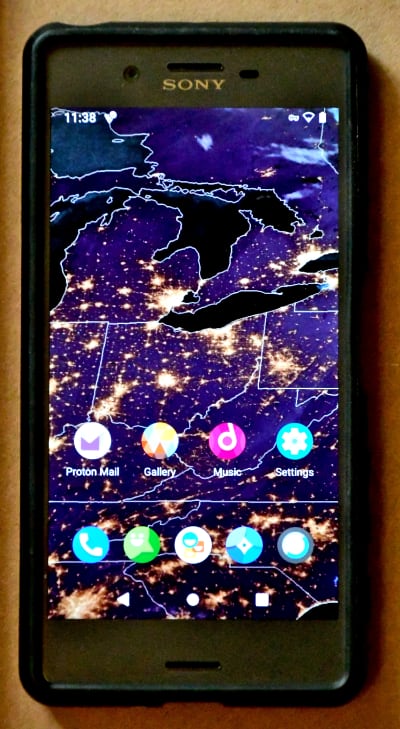
Ah, but then!
For some reason the Lineage people and those at related projects do not say that here is this version of this OS for this device. They use nonsensical codenames. The name they use for the Xperia X is “suzu” — how could I have avoided guessing that? (That was sarcasm.) I looked on the MicroG-Lineage download site, scrolled down and down and down, and found “suzu.”
I got the software I needed, followed the instructions for a hair-raising 45 minutes (I think the USB cable I was using had developed an intermittent problem), and miraculously booted into a pretty much fully de-Googled Android. Within a few minutes I had downloaded, installed, and configured ProtonVPN, not from the PlayStore but from a non-Google repository called FDroid. ProtonMail was still on the micro-SD card that had been inside the phone throughout, and it took about two minutes to install and configure.
Here’s some advice: Don’t undertake this kind of thing at 10 p.m., because while you’ll have done the installation by 11, you’ll be up half the night configuring the thing, downloading and trying new applications, getting used to the many annoyances in the Android way of doing things, and still not be done.
Still, that tiny screen is a stopgap. It’s small now and my eyes are getting no younger. I wondered if my morning matcha would be as pleasant if I were at the same time squinting through reading glasses at that small, albeit high-definition panel.
My decision?
I’ll get a refurbished iPad and live with MicroG and Lineage as I wait for Ubuntu Touch to add the essentials.
And maybe with the parts from the old iPad and some of the parts from the PlayBooks, and that old DirecTV satellite dish, and, who knows, that old Nexus, I could build . . .

Dennis E. Powell is crackpot-at-large at Open for Business. Powell was a reporter in New York and elsewhere before moving to Ohio, where he has (mostly) recovered. You can reach him at dep@drippingwithirony.com.
You need to be logged in if you wish to comment on this article. Sign in or sign up here.
Join the Conversation
Re: Making It
This reminds me of my attempts to likewise get Android on my HP TouchPad. I paid for a Kickstarter that was supposed to help with that, but never amounted to much, way back when. I also backed the Pine64 single board computer on Kickstarter and tried to get it to run some useful variant of Android or Linux, but everything was either terribly outdated or not very useful. (I finally bought a Raspberry Pi to quench that particular thirst, but somehow managed to lose that, so my tinkering has not been successful thus far.)
Re: Making It
My little Planet Computers Gemini was on Kickstarter (or the other crowd-fund site) and it worked out pretty well. Decent device fatally flawed, not by its binary blobs, though they’re a worry) but by its lack of a pointing device. IOS works with fingers; to a lesser extent so does Android. But poking your finger over the keyboard is awkward to say the least. Though the KDE people (or Gemini hackers — hard to keep straight) improved the response of the mouse pointer such that Plasma is actually usable on it. But it, too, has a small screen.
I cropped the dead android from the shot above, cleaned it up a little, and find that it makes a nice, amusing, and ironic lock-screen image for me deGoogled Xperia X, which I confess to liking more and more. If we had cellular service here I would buy it a SIM card, but we don’t, so it’s hard enough to justify one cellular phone!